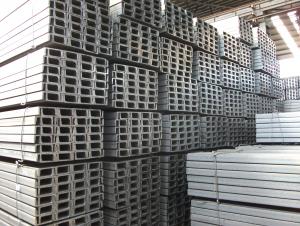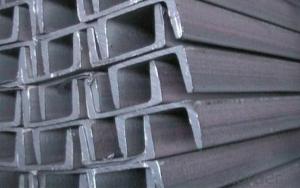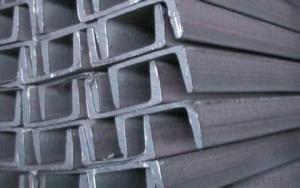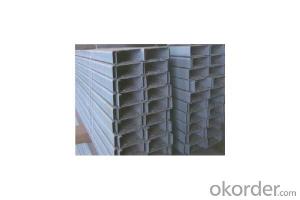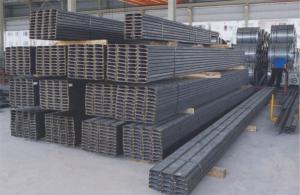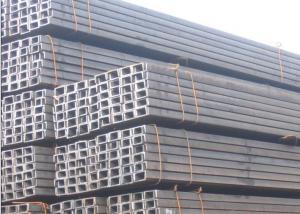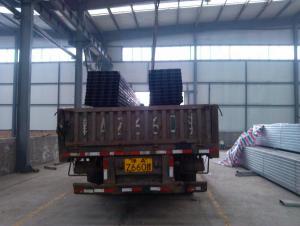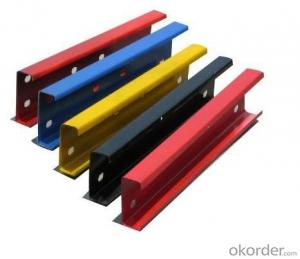Hot Rolld Steel U-channel with Many Standards Q235
- Loading Port:
- China Main Port
- Payment Terms:
- TT or LC
- Min Order Qty:
- -
- Supply Capability:
- -
OKorder Service Pledge
OKorder Financial Service
You Might Also Like
Product Description:
OKorder is offering STEEL CHANNEL at great prices with worldwide shipping. Our supplier is a world-class manufacturer of steel, with our products utilized the world over. OKorder annually supplies products to European, North American and Asian markets. We provide quotations within 24 hours of receiving an inquiry and guarantee competitive prices.
Product Applications:
The steel u channel can be applied to construction of warehouses, workshops, sport stadiums and car parks etc. In details, the steel u channel belongs to carbon structural steel which is applied to in the field of construction and machinery. The steel u channel is usually used for arch-itechtural structure, and they could be welded in order to support or hang a vari-ety of facilities. They are also usually used in combination with I beam. Generally,the steel u channel must possess perfect welding property, riveting property and mechanical property and so on.
Product Advantages:
OKorder's STEEL CHANNELare durable, strong, and resist corrosion.
Main Product Features:
· Premium quality
· Prompt delivery & seaworthy packing (30 days after receiving deposit)
· Corrosion resistance
· Can be recycled and reused
· Mill test certification
· Professional Service
· Competitive pricing
Product Specifications:
Minimum Order Quantity: 25 Tons Unit: m.t. Loading Port: Xingang Port
Supply Ability: 1000 Tons Per Day Payment Terms: TT or L/C
Product Description:
Specifications of Steel U Channel:
Standard Applied: GB Standard, EN Standard(UPN), JIS Standard
Sizes: 50mm to 300mm
Material Grade: Q235B, Q345B, S235JR, SS400, ASTM A36
Usage/Application of Steel U Channel:
The steel u channel can be applied to construction of warehouses, workshops, sport stadiums and car parks etc. In details, the steel u channel belongs to carbon structural steel which is applied to in the field of construction and machinery. The steel u channel is usually used for arch-itechtural structure, and they could be welded in order to support or hang a vari-ety of facilities. They are also usually used in combination with I beam. Generally,the steel u channel must possess perfect welding property, riveting property and mechanical property and so on.
Package & Delivery: Steel U Channel
The steel u channel will be packed in bundle with steel wire at each end of every bundle and color marking in order to help the customer to recognize his goods more easily at sight.
And steel u channel could be loaded into 20ft or 40ft container, or by bulk cargo. If the weight of each bundle reaches less than 3.5 mt, the loading by break bulk cargo should be choosed. When the weight of each bundle reaches less than 3mt, the loading by container should be choosed.
As for the transportaion from mill to loading port, the truck will be usually used. And the maximum quantity for each truck is 40mt.
All in all, we could do in accordance with customer's request
Alloy No | Grade | Yielding Strength Point(Mpa) | |||
Thickness(mm) | |||||
≦16 | >16-40 | >40-60 | >60-100 | ||
≧ | |||||
Q235 | B | 235 | 225 | 215 | 205 |
Alloy No | Grade | Tensile Strength(Mpa) | Elongation After Fracture(%) | |||
Thickness(mm) | ||||||
≦16 | >16-40 | >40-60 | >60-100 | |||
≧ | ||||||
G235 | B | 375-500 | 26 | 25 | 24 | 23 |
FAQ:
Q1: Why buy Materials & Equipment from OKorder.com?
A1: All products offered byOKorder.com are carefully selected from China's most reliable manufacturing enterprises. Through its ISO certifications, OKorder.com adheres to the highest standards and a commitment to supply chain safety and customer satisfaction.
Q2: How do we guarantee the quality of our products?
A2: We have established an advanced quality management system which conducts strict quality tests at every step, from raw materials to the final product. At the same time, we provide extensive follow-up service assurances as required.
Q3: How soon can we receive the product after purchase?
A3: Within three days of placing an order, we will begin production. The specific shipping date is dependent upon international and government factors, but is typically 7 to 10 workdays.
Q4: What makes stainless steel stainless?
A4: Stainless steel must contain at least 10.5 % chromium. It is this element that reacts with the oxygen in the air to form a complex chrome-oxide surface layer that is invisible but strong enough to prevent further oxygen from "staining" (rusting) the surface. Higher levels of chromium and the addition of other alloying elements such as nickel and molybdenum enhance this surface layer and improve the corrosion resistance of the stainless material.
Images:


- Q: What are the guidelines for steel channel installations in seismic zones?
- To ensure the structural integrity and safety of buildings during seismic events, it is crucial to follow guidelines for steel channel installations in seismic zones. These guidelines are developed based on engineering principles, regulatory bodies, and industry standards. 1. Considerations for Design: When designing steel channel installations in seismic zones, it is important to consider seismic forces, building geometry, and structural connections. A qualified structural engineer should be responsible for the design, taking into account project-specific requirements. 2. Material Selection: It is recommended to use high-quality steel channels that meet the specifications outlined in relevant standards such as ASTM A36 or ASTM A572. Before installation, the channels should be inspected for defects. 3. Connection Details: Proper connection details are essential for withstanding seismic forces. Welding or bolting should be done following approved methods and standards. Connections should be designed to resist both vertical and lateral forces, ensuring overall structure stability. 4. Anchorage: Steel channel installations should be securely anchored to the building's foundation or structural system. Design specifications should dictate the use of anchor bolts or other approved anchorage methods capable of withstanding anticipated seismic forces. 5. Seismic Bracing: Additional bracing may be necessary in seismic zones to enhance the stability of steel channel installations. Diagonal braces or moment frames should be designed and installed to resist lateral forces. The bracing layout and connections should comply with relevant codes and standards. 6. Inspection and Quality Control: Qualified personnel should regularly inspect steel channel installations to ensure compliance with design specifications and codes. Quality control measures should be implemented to monitor the manufacturing, fabrication, and installation processes. 7. Compliance with Local Codes: Familiarity with and adherence to specific seismic design codes and regulations in the project's location is essential. Consultation with local building authorities is necessary to meet all applicable requirements. Ultimately, the guidelines for steel channel installations in seismic zones aim to create safe and resilient structures capable of withstanding seismic forces. Engaging the expertise of qualified professionals, such as structural engineers, is crucial to accurately follow the guidelines and meet necessary standards.
- Q: Difference between steel channel and channel steel!
- It shouldn't make any difference, but I'm not sure.
- Q: Do steel channels have any specific vibration damping properties?
- Although steel channels possess certain inherent vibration damping properties, their effectiveness may not be on par with materials designed specifically for vibration damping. Due to their solid and rigid structure, steel channels are capable of absorbing and dissipating vibration energy to some extent. This is due to the relatively high density of steel, which enables it to absorb and distribute vibration energy more efficiently than lighter materials. Moreover, the shape and geometry of steel channels also contribute to their vibration damping properties. The design of the channel, including its cross-sectional shape and dimensions, can impact its ability to dampen vibrations. However, it is important to acknowledge that when it comes to vibration damping, steel channels may not be as efficient as materials engineered specifically for this purpose, such as elastomers or composite materials. These materials possess properties that are tailored specifically to dissipate vibrations, offering superior damping characteristics compared to steel channels. Consequently, while steel channels do possess inherent vibration damping properties, they may not be the most optimal choice for applications that require significant vibration damping.
- Q: How do steel channels perform in extreme temperatures?
- Steel channels are renowned for their exceptional performance in extreme temperatures, exhibiting a remarkable ability to withstand high heat without warping or deforming due to their high melting point. As a result, they find extensive use in industries demanding heat resistance, such as automotive, aerospace, and construction sectors. In addition, steel channels exhibit impressive performance even in frigid temperatures. This is attributed to the fact that steel possesses a low coefficient of thermal expansion, meaning it undergoes minimal contraction or expansion when subjected to temperature fluctuations. Consequently, steel channels retain their structural integrity and dimensional stability even in freezing conditions. Moreover, steel channels boast excellent thermal conductivity, enabling efficient heat transfer. This attribute proves particularly advantageous in extreme temperature environments, as it ensures the uniform distribution of heat, preventing the formation of localized hot spots or cold spots. Taken together, the reliability of steel channels in extreme temperatures renders them the preferred choice for various applications where temperature resistance is of utmost importance.
- Q: Are steel channels suitable for railway infrastructure projects?
- Yes, steel channels are suitable for railway infrastructure projects. They offer excellent strength, durability, and load-bearing capacity, making them ideal for constructing railway tracks, bridges, and other related structures. Steel channels also possess corrosion resistance and can withstand heavy traffic and varying weather conditions, making them a reliable choice for long-lasting railway infrastructure.
- Q: Are steel channels suitable for architectural feature elements?
- Yes, steel channels can be suitable for architectural feature elements. Steel channels are strong, durable, and versatile, making them suitable for various architectural applications. They can be used to create unique and visually appealing architectural elements such as decorative screens, columns, beams, and facades. Additionally, steel channels offer great structural support, allowing architects to design intricate and complex feature elements.
- Q: How do steel channels contribute to the overall stability of a building?
- Steel channels play a vital role in maintaining the overall stability of a building through various means. Firstly, they provide structural support and reinforcement to the building's framework. Steel channels are commonly utilized as beams or columns, distributing the building's weight and resisting bending or buckling when subjected to a load. This additional strength and rigidity guarantee the building's ability to withstand external forces and remain structurally sound. Moreover, steel channels enhance the building's ability to resist lateral forces like wind or earthquakes. By strategically placing steel channels in key locations within the building's framework, they can act as bracing elements, effectively transferring and dissipating these lateral forces. This helps minimize the building's deflection, sway, and potential damage during high winds or seismic events. Additionally, steel channels play a crucial role in supporting the building's floor and roof systems. They serve as primary load-bearing elements that carry the weight of these components and transfer it to the building's foundation. This ensures that the floors and roofs remain level, preventing any sagging or collapsing that could compromise the stability of the entire structure. In addition to their structural contributions, steel channels offer advantages in terms of versatility and cost-efficiency. They come in various sizes and shapes, allowing for customization and adaptation to different architectural designs and construction requirements. Furthermore, steel channels are durable and possess a high strength-to-weight ratio, making them a cost-effective choice for enhancing a building's stability. Overall, steel channels are indispensable components in modern construction. They provide essential structural support, enhance resistance to lateral forces, support floor and roof systems, and offer versatility and cost-efficiency. Incorporating steel channels into a building's design and construction significantly improves its overall stability and integrity.
- Q: Can steel channels be used for mezzanine office spaces?
- Yes, steel channels can be used for mezzanine office spaces. Steel channels provide strong support and structural stability, making them suitable for constructing elevated floors in mezzanine office spaces. They can effectively bear the weight of office furniture, equipment, and occupants, ensuring a safe and durable structure.
- Q: What are the different types of connections used for steel channels in steel bridges?
- Steel bridges commonly use several different types of connections to join steel channels. These connections play a crucial role in maintaining the bridge's structural integrity and stability. One frequently used connection type for steel channels is the bolted connection. This method involves connecting steel channels using bolts and nuts. The bolted connection offers flexibility and ease of assembly and disassembly, making it a popular choice in bridge construction. Another connection type is the welded connection, where steel channels are joined by welding. This creates a strong and permanent connection, often used in areas requiring high load transfer and rigidity. While riveted connections were once common in older steel bridges, they are less prevalent in modern bridge construction. Riveted connections involve joining steel channels using rivets, metal pins hammered or pressed through holes in the channels. Riveted connections offer good load transfer and durability but are more time-consuming and labor-intensive compared to bolted or welded connections. In addition to these common connection types, proprietary connection systems are available in the market. These systems, designed and manufactured by specific companies, offer unique advantages such as improved performance, increased construction speed, or cost savings. They may utilize mechanical fasteners, adhesives, or hybrid connections to join steel channels in steel bridges. Ultimately, the choice of connection type depends on various factors, including design requirements, loadings, fabrication capabilities, cost considerations, and durability requirements. Bridge engineers and designers must carefully assess these factors to select the most appropriate connection type, ensuring the safety and longevity of steel bridges.
- Q: Can steel channels be used for equipment racks?
- Yes, steel channels can be used for equipment racks. Steel channels provide a sturdy and durable framework that can support heavy equipment and provide excellent structural integrity for equipment rack installations.
Send your message to us
Hot Rolld Steel U-channel with Many Standards Q235
- Loading Port:
- China Main Port
- Payment Terms:
- TT or LC
- Min Order Qty:
- -
- Supply Capability:
- -
OKorder Service Pledge
OKorder Financial Service
Similar products
Hot products
Hot Searches
Related keywords

















